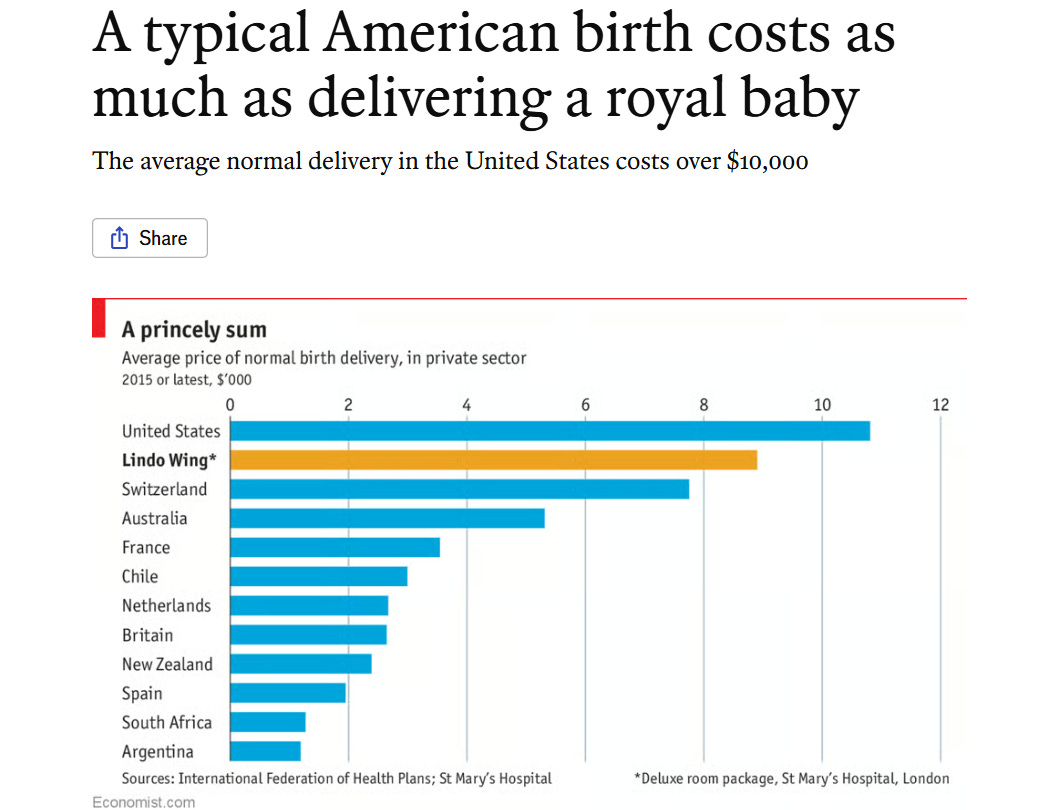Is Midwifery Red, Blue or...Purple?
My journey to understand where midwifery fits in today's polarized political landscape
If you follow the politics of healthcare in the U.S, you know that we’ve got problems. To put it simply, we spend more money for worse outcomes. This definitely applies to maternal health. By one estimate, health costs associated with pregnancy, childbirth and postpartum care average $18,865. After Duchess Kate Middleton gave birth in the Lindo Wing, a private maternity ward at a hospital in London, The Economist mused that her birth was still cheaper than a typical American vaginal birth. Yet our rates of maternal and infant mortality are among the worst of rich nations.
This is embarrassing, people.
Because my life goal as a certified nurse-midwife (CNM) is to improve the outcomes and experiences of pregnant and childbearing women by expanding access to midwifery, I often ask myself: Do my goals align more closely with the Democratic or Republican party? And most of the time, the answer neither.
Sure, every politician and policy-maker says they care about moms. But in reality, the poor state of maternity care in the U.S. is like, number 93 on any given candidate’s top 100 list. And even when they do recognize it as a problem, midwifery barely registers as one of the solutions. The fact that we’re completely sitting on an option that could tackle both the high cost and poor quality of care at the same time isn’t surprising—but it’s deeply frustrating.
For the full story of how midwifery came to be marginalized in the U.S., why this is different in other countries, and how much this has cost us as a country, you can read my STAT piece. But for now, here’s my argument:
Expanding access to midwifery and integrating more midwives into the U.S. healthcare system has potential to address two of our biggest challenges in maternity care: poor outcomes, and sky-high costs.
Just to clarify, when I talk about midwifery in this essay, I am referring to both Certified Nurse-Midwives (CNMs) who typically attend hospital births, and other kinds of midwives, like Certified Professional Midwives (CPMs) who more often attend home births or birth center births. There are for sure some differences between these groups, but what unites us is more than what divides us—and that’s a topic for another post. If you want to have a greater understanding of the different kinds of midwives and where they work, this Government Accountability Office report is a great resource. But an important fact you should understand is that the vast majority of midwife-attended births in the U.S. occur in hospitals and are attended by CNMs (about 92%).
On to the benefits of midwifery. This is by no means an exhaustive list, but various studies have shown midwifery to:
Decrease C-section and operative vaginal birth (vacuum or forceps assist)
There’s also this study, a comprehensive look into the state-by-state availability of midwifery care, laws governing midwifery, and number of midwife-attended births which determined that states with greater midwifery integration had:
“…significantly higher rates of spontaneous vaginal delivery, vaginal birth after cesarean and breastfeeding, and significantly lower rates of cesarean, preterm birth, low birth weight infants, and neonatal death. [Midwifery integration scores] also correlated with density of midwives and access to care across birth settings. Significant differences in newborn outcomes accounted for by [midwifery integration scores] persisted after controlling for proportion of African American births in each state.”
How much money might expanding midwifery save? One study estimated birth center care from midwives would save about $1,163 per birth, or $11.6 million per 10,000 births. And another estimated that expanding midwifery care to 100% of low risks births in the U.S. could save as much as $340 million per year. I’m not an economist, but these seem like big numbers to me.
Ok, that’s the extent of my money talk…
Because honestly, you could argue that saving money isn’t even the point. If we knew that pouring tons of money into our maternity care system were going to improve the lives of moms and babies, it might be worth it. But right now, we’re seeing the opposite: people already have widespread access to high-cost technologies and interventions during pregnancy and childbirth like:
Ultrasounds (4-5 on average per pregnancy)
Genetic testing (70% of pregnancies)
Epidural anesthesia (71% of labors)
Continuous electronic fetal monitoring (85% of labors)
C-section (32.3% of births in the U.S.)
And yet…all the money we’re pouring into these interventions isn’t translating into better outcomes for moms and babies. In some cases, we may have hit the point of diminishing returns where these technologies are not only failing to help but are actually making things worse. I have already written a post about how “The C-section Rate Doesn’t Have To Be This High,” and could probably write a 5,000 word essay about the overuse of some of these other technologies as well.
But, for today, I just want to make the point that there are some basic, evidence-based, and comparatively cheap interventions shown to improve outcomes that most women giving birth in America don’t have access to:
Doulas (only 6% of women have one, most pay for it themselves out-of-pocket)
Midwifery care (only 12% of births in the U.S. are attended by midwives)
Warm water bath during labor (Use during labor reported at 6%)
Freedom of movement and position change during labor (the 15% that don’t have continuous EFM, which usually tethers you to your bed, see above)
Freedom to drink and eat during labor (60% don’t drink, 80% don’t eat)
If you need more convincing, consider this: the countries with the best maternal and infant outcomes in the world have one important thing in common: midwifery care isn’t a niche option for a few women who happen to live in the right area and have the time and resources to seek it out— it’s the default.
And I want to be clear that we’re not without midwifery care in the U.S. because women don’t want it: this survey of racially diverse moms show that many more women want a midwife than have access to one…and this data came from California, which actually has better access to midwives than most states. The real issue is that our healthcare system has a long history of sidelining midwives: underinvesting in midwifery education, allowing healthcare systems and hospitals to exclude midwives from practice, and enacting laws and policies that make it harder for midwives to work.
So, health care should be a fairly non-partisan topic, but it’s clear that the two major political camps approach the problem from different angles. Democrats/Progressives/Liberals tend to push for policies that expand access to care, with a focus on the underserved. Meanwhile, Republicans/Conservatives are more focused on achieving lower costs through decreased wasteful spending and market competition. Hey, guess what? Midwifery can help you both!
Yet when I look around the world of midwifery in the U.S., I feel some cognitive dissonance. On the one hand, midwifery has strong appeal among religious conservatives—think Mormons, Orthodox Jews, Amish, Mennonites, and Catholic families who often favor larger families. On the other hand, it’s also embraced in progressive, feminist “earthy-crunchy” enclaves like the Pacific Northwest. This odd coalition suggests midwifery is not inherently partisan. It speaks to shared values across the political spectrum—values like autonomy, family, stewardship of resources, and respect for women’s choices. Maybe that’s why it has quietly built a foothold in diverse communities, even while being excluded by mainstream U.S. health policy.
Yet, if forced to pick a side, midwifery feels a lot more blue than red right now.
I looked into the the 5 states with the highest and lowest rates of midwife-attended births to see if they had much in common politically and…sort of? Here’s a list highlighted in the colors that describe the way they voted in the last two elections (red=GOP both times, blue=Dems twice)

So in trying to come up with what these states have in common, I notice that all are pretty cold except New Mexico. 🥶 Perhaps at the historical stage where midwifery was being blasphemed out of existence in the United States, these states were just too far away to bother with, so some of their midwifery infrastructure was left untouched?
Now here are the 5 states with the lowest rates of midwife-attended births. They look pretty red to me:

In conclusion, midwifery is probably a little more blue than it is red, but it’s also sort of purple. There are good reasons for both parties to make expanding midwifery a priority. It offers solutions that speak to liberal goals like expanding access and equity, while also aligning with conservative goals of lowering costs and empowering families to make their own choices. Midwives have important contributions to make in fixing our broken maternity care system—contributions that could benefit many American moms and babies.
I’m tired of training midwifery students who struggle to find jobs, while at the same time hearing from moms who say they wanted a midwife but didn’t have access to one.
If lawmakers, policymakers, healthcare professionals (including physicians, nurses and all kinds of midwives) could just sit down, set aside turf wars, and work together to integrate midwifery more fully, we could build a system that is not only more affordable but has much better outcomes for moms and babies.
As always, I welcome respectful questions and differing opinions from readers who want to engage with what I’ve written!






Yes!! Such a great example of a cause that could have bipartisan support and make a huge impact on our collective well-being. (Also, one of my besties is a certified nurse midwife so I kinda feel like I am part of the club.)
We have predominantly midwife led care in the UK….probably because it’s the cheapest way to get good outcomes for mothers and babies as we’re state-funded 🤣 But it works! Completely agree that it’s something both sides of the political aisle could get on board supporting.
I think midwife led care should be the standard, and I say this as someone who has always ended up in consultant-led care due to medical reasons. Save the doctors for when there’s really a problem!